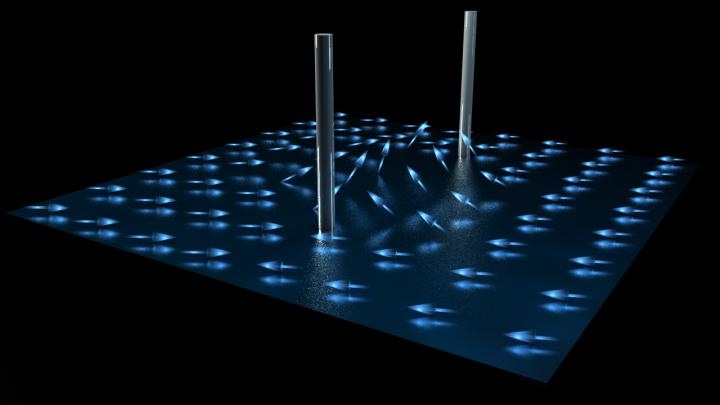Dec 15 2016
 A half-quantum vortex combines circular spin flow and circular mass flow, leading to the formation of vortex pairs that can be observed experimentally. Credit: Ella Maru Studio
A half-quantum vortex combines circular spin flow and circular mass flow, leading to the formation of vortex pairs that can be observed experimentally. Credit: Ella Maru Studio
Half-quantum vortices in superfluid helium have been discovered by researchers at Aalto University, Finland, and P.L. Kapitza Institute in Moscow. This vortex is considered to be a topological defect, seen in superconductors and superfluids, which carries a specific amount of circulating current.
This discovery of half-quantum vortices culminates a long search for these objects originally predicted to exist in superfluid helium in 1976. In the future, our discovery will provide access to the cores of half-quantum vortices, hosting isolated Majorana modes, exotic solitary particles. Understanding these modes is essential for the progress of quantum information processing, building a quantum computer.
Samuli Autti, Doctoral Candidate, Aalto University
A few central limitations and a number of possibilities are provided by macroscopic coherence in quantum systems, such as superconductors and superfluids. For example, the laws of quantum mechanics place a limitation on certain discrete values as far as the strength of circulating currents in these systems is concerned.
A half-quantum vortex uses the non-trivial topology of the underlying material to overcome this limitation, which is a topic directly related to the 2016 Nobel Prize in physics.
Among the many emerging properties is one corresponding to the so-called Alice string feature in high-energy physics. According to this feature, a particle traveling around the string flips the sign of its charge. In general, the quantum character of these systems is already being used in ultra-sensitive SQUID amplifiers and various other significant quantum devices.
The recent issue of the online version of Physical Review Letters features the article titled Observation of Half-Quantum Vortices in Topological Superfluid 3He. Experiments were performed in the Low Temperature Laboratory at Aalto University.